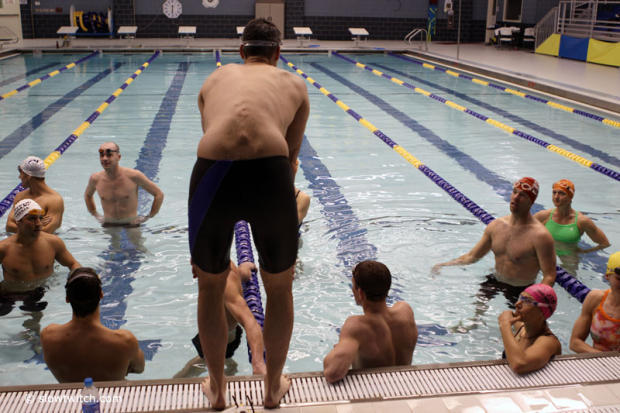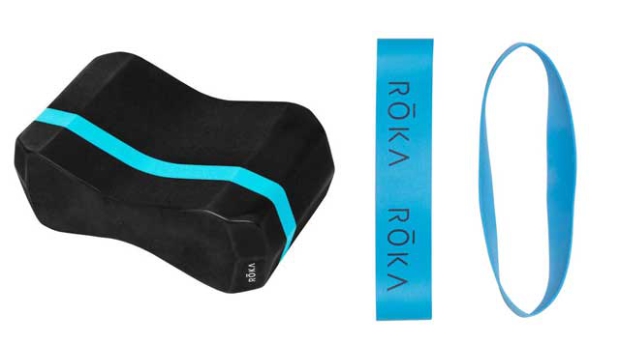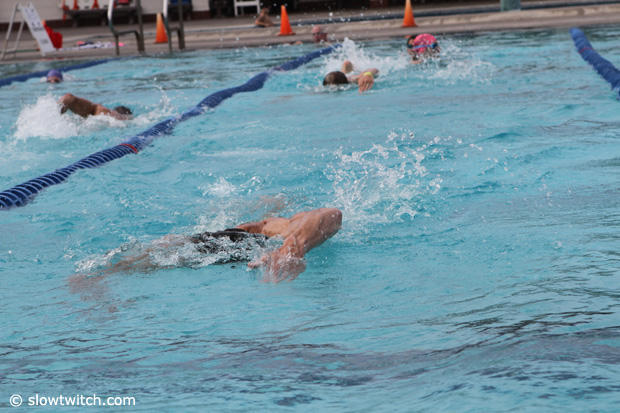Guppy Challenge: Week 2
We have some great swim coaches in triathlon and my measure for “greatness” is the ability to teach and coach adult-onset swimmers. Adults learn via a different pathway, and being a good swim coach for triathletes is a lot like teaching English as a second language versus teaching English grammar to kids. (Slowtwitch Coaching produces a curriculum for this, and we'll be teaching coaches how to instruct from the pooldeck for adult onset swimmers in January upcoming, in Tempe, Arizona).
In my formative adult-onset-swim years, many years ago(!), a coach apparently not tutored in teaching adults told me, “You’re over-reaching.”
Okay, I tried to fix that.
“No! You’re not extending! You need to extend!” So I extended. “No, you’re over-reaching!” And this is how it went for about 6 months. I finally understood what she was saying, about 5 years later, only in retrospect. She failed at her attempts to explain to me what she meant.
But I’m getting ahead of myself! This thing of extending and over-reaching, nebulous as these terms are, refer to the “catch” phase of the stroke and we’re not quite there yet. My interest now is in your “hull.” You can replace a 150hp boat motor with a 300hp motor and the boat won’t really go any faster if its hull is only designed for low speed. That’s why many of you give up trying to get better at swimming. Your motor keeps getting more powerful but you don’t get any faster.

Improving the shape of your hull is, at least for now, an exercise in 2 planes. We need to get your feet up on the surface, that’s the vertical plane. And we need to keep your feet from moving side to side, that’s the horizontal plane. There are 2 ways to do this:
1. A drill that exposes how bad you are, that is, a drill that makes swimming harder than it is, a drill that artificially makes swimming harder for you, and exposes the weak part of your technique.
2. A drill that shows you what good feels like, that is, a drill that artificially makes swimming easier for you.
Both drills are valid. As we move further into the Guppy Challenge, and we talk about a drill, I'll usually tell you what kind of a drill it is of the 2 kinds above.
Here's a drill that tortuously exposes a technical weakness. Pure torture. Valuable torture, maybe, but not for you! You’re notready for this (if anyone ever is!).
If we float your legs artificially we can make swimming easier for you, and show you what GOOD feels like. Banding your ankles (or somehow mandating your ankles remain in close proximity to each other), while floating your ankles makes swimming harder on one plane, but easier in another. It's a mix of the two types of drills described above.
Putting a buoy between your legs is a tool that shows you what GOOD feels like in the vertical plane: that’s where your legs need to be! It also exposes what BAD feels like in the horizontal plane: If a buoy forces your feet to stay together you can’t splay them to counteract your bending at the waist when you breathe.
What is your takeaway from the above? Don’t just do the drill. Thing about the purpose of the drill. As we talk in upcoming weeks about band tying the ankles; bands fixing the ankles at a certain distance from each other; pull buoys; wetsuit arms; center snorkels; one-arm pulls; think about what these are trying to get you to do. Think about whether these are exposing a flaw by magnifying it, or erasing your flaw and showing you what GOOD feels like.
If you don't know what the drill is supposed to do, our Reader Forum will have threads on the Guppy Challenge from now through the end of this Challenge.
Let's get down to practice! Here is a great video explaining what "banded ankles" gets at. In this video, of course, the ankles aren't banded or tethered. The swimmer is simply grabbing a pull buoy with his ankles. And that's fine. But some of you might find it difficult to keep hold of that buoy. So, below is an image of a pull buoy and an ankle band (each by ROKA). Securing your ankles with the band, with the buoy between your ankles, will make this drill easier for many of you. I've got some pull buoys made for this purpose on their way to me; I'll report on their effectiveness when I use them.

Just, the point of keeping the ankles in close proximity to each other, while floating the ankles, helps you both make the changes in your technique that allow you to rotate your body like you're "in a tube" while also giving you a sense of where your feet need to be (make bubbles with your kick!).
Guppy Challenge, Week-2, Workout-1
Warm-Up Set => 6 x 50yd freestyle, easy, slow, establish a leave interval that gives you 10sec rest between each 50.
Style Set 1 => 4 x 100yd alternating 1-arm pull and freestyle, moderate pace, 10sec rest between each.
Style Set 2 => 3 x 100yd with buoy or other flotation device (inflated wheelbarrow tube?) between or around ANKLES (not thighs), using an exercise band if needed to keep everything together.
Main set =>
GUPPIES => 5 x 200yd: moderate pace, leave interval allowing 10-15sec rest between each.
TARPONS => 8 x 200yd
TUNAS => 10 x 200yd
Total Guppy yards this workout: 2000
—
Guppy Challenge, Week-2, Workout-2
Warm-Up Set => 50yd freestyle, 10sec rest, 100yd free, 10sec rest, 150yd free.
Style Set 1 => 3 x 100yd alternating 1-arm pull and freestyle, moderate pace, 10sec rest between each.
Style Set 2 => 3 x 100yd Your choice: either banded/floated ankles or wetsuit sleeves. Or both!
Main set =>
GUPPIES => 6 x 150yd: establish a leave interval that gives you a reasonably stiff workout while giving you about 10sec rest between each. See if you can swim all these in the same time.
TARPONS => 9 x 150yd
TUNAS => 12 x 150yd
Warm-Down => 200yd swimdown easy
Total Guppy yards this workout: 2000
—
Guppy Challenge, Week-2, Workout-3
Warm-Up Set => 6 x 50yd freestyle, easy, slow, establish a leave interval that gives you 10sec rest between each 50.
Style Set 1 => 6 x 50yd freestyle, with floated and banded ankles, endeavoring to keep your body in-line rather than swiveling at the waist. This is a great set to do with a center snorkel if you have one.
Kick Set => 4 x 50yd kicking.
Main set =>
GUPPIES => down-ladder: 400, 300, 200, 100yd, on your leave.
TARPONS => down-ladder: 500, 400, 300, 200, 100yd, on your leave.
TUNAS => up-down-ladder: 100, 200, 300, 400, 300, 200, 100, on your leave.
Warm-Down => 200yd swimdown easy
Total Guppy yards this workout: 2000
—
Guppy Challenge, Week-2, Workout-4 Extra Credit!
Many of you will do just 3 workouts a week swimming. Fine. But for those who want to go down deep and stay down long, here are workouts #4 and #5.
Warm-Up Set => 50yd freestyle, 10sec rest, 100yd free, 10sec rest, 150yd free.
Style Set 1 => 6 x 100yd alternating 1-arm pull and freestyle, moderate pace, 10sec rest between each.
Style Set 2 => 4 x 50yd, with buoy or with symmetric snorkel.
Main set =>
GUPPIES => 2 sets of 2 x 200yd swim, on your interval, 50 kick after each set (That's 900 total yards)
TARPONS => 2 sets of 3 x 200yd swim, on your interval, 50 kick after each set
TUNAS => 2 sets of 4 x 200yd swim, on your interval, 50 kick after each set
Warm-Down => 100yd easy warm down
Total Guppy yards this workout: 2100
—
Guppy Challenge, Week-2, Workout-5 Extra Extra Credit!
Warm-Up Set => 2 x 50yd, 2 x 100, 2 x 150 freestyle, easy! On a leave interval 5sec to 10sec slower than your regular leave interval.
Style Set 1 => 6 x 100yd: swim the 1st and 3rd 50 as slow as you can! Swim the 2nd and 4th 50 normal.
Kick Set => 4 x 50yd kicking.
Main set =>
GUPPIES => 400yd straight swim, every 2nd 50 is slow, every 4th 50 is sprint
TARPONS => 500yd straight swim, every 2nd 50 is slow, every 4th 50 is sprint
TUNAS => 1000yd straight swim, every 2nd 50 is slow, every 4th 50 is sprint
Warm-Down => 200yd easy warm down
Total Guppy yards this workout: 2000
—
Total Guppy weekly yardage
If you do the first 3 workouts: 6000yd
These plus the 4th workout: 8100yd
All 5 workouts: 10,100yd
Last week I mentioned "wetsuit sleeves" and I mention them again here. De Soto's Extreme Sleeves are an example. This is one of those drills that makes swimming easier, to show you how "good" feels. These make it easier for you to keep your forearms on the surface, superman style, after the catch and during the extend phase, or whatever you want to call that phase between the fairly short time your hand enters the water and the time you begin your pull. We'll talk about "swimming over a barrel" and "high vertical forearm" and all of this presupposes your hand and forearm are cocked and ready to start the pull correctly. That hand near the water's surface before the pull commences? That's the point of the sleeves, to float your forearm and keep it near the surface. If you're going to use this tool, use it right!





Start the discussion at slowtwitch.northend.network